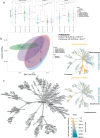A meta-analysis of acetogenic and methanogenic microbiomes in microbial electrosynthesis
- PMID: 36138044
- PMCID: PMC9500080
- DOI: 10.1038/s41522-022-00337-5
A meta-analysis of acetogenic and methanogenic microbiomes in microbial electrosynthesis
Abstract
A meta-analysis approach was used, to study the microbiomes of biofilms and planktonic communities underpinning microbial electrosynthesis (MES) cells. High-throughput DNA sequencing of 16S rRNA gene amplicons has been increasingly applied to understand MES systems. In this meta-analysis of 22 studies, we find that acetogenic and methanogenic MES cells share 80% of a cathodic core microbiome, and that different inoculum pre-treatments strongly affect community composition. Oxygen scavengers were more abundant in planktonic communities, and several key organisms were associated with operating parameters and good cell performance. We suggest Desulfovibrio sp. play a role in initiating early biofilm development and shaping microbial communities by catalysing H2 production, to sustain either Acetobacterium sp. or Methanobacterium sp. Microbial community assembly became more stochastic over time, causing diversification of the biofilm (cathodic) community in acetogenic cells and leading to re-establishment of methanogens, despite inoculum pre-treatments. This suggests that repeated interventions may be required to suppress methanogenesis.
© 2022. The Author(s).
Conflict of interest statement
The authors declare no competing interests.
Figures






References
-
- Grim RG, et al. Transforming the carbon economy: challenges and opportunities in the convergence of low-cost electricity and reductive CO2 utilization. Energy Environ. Sci. 2020;13:472–494.
-
- Karthikeyan R, Singh R, Bose A. Microbial electron uptake in microbial electrosynthesis: a mini-review. J. Ind. Microbiol. Biotechnol. 2019;46:1419–1426. - PubMed
-
- Dessì P, et al. Microbial electrosynthesis: Towards sustainable biorefineries for production of green chemicals from CO2 emissions. Biotechnol. Adv. 2021;46:107675. - PubMed
-
- Jourdin L, Freguia S, Flexer V, Keller J. Bringing high-rate, CO2‑based microbial electrosynthesis closer to practical implementation through improved electrode design and operating conditions. Environ. Sci. Technol. 2016;50:1982–1989. - PubMed
-
- Claassens NJ, Cotton CAR, Kopljar D, Bar-Even A. Making quantitative sense of electromicrobial production. Nat. Catal. 2019;2:437–447.
Publication types
MeSH terms
Substances
LinkOut - more resources
Full Text Sources
Miscellaneous

